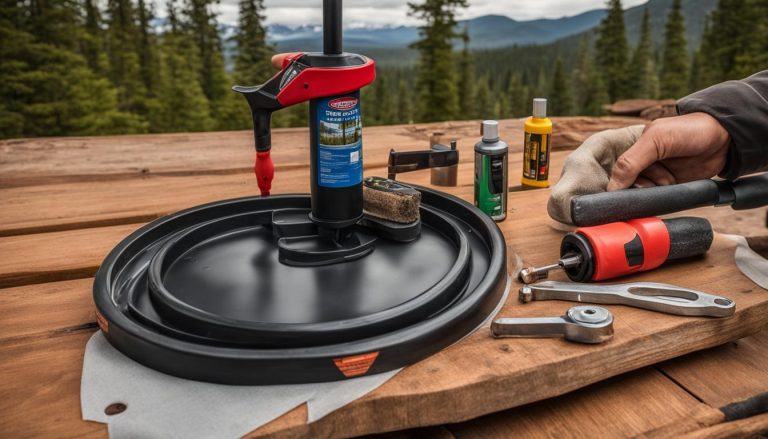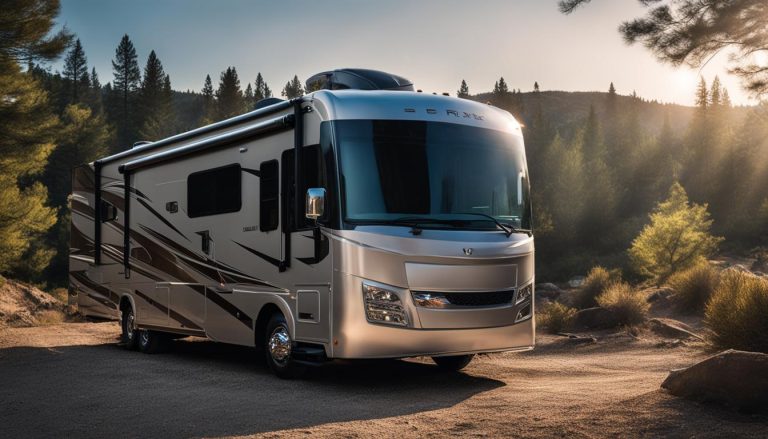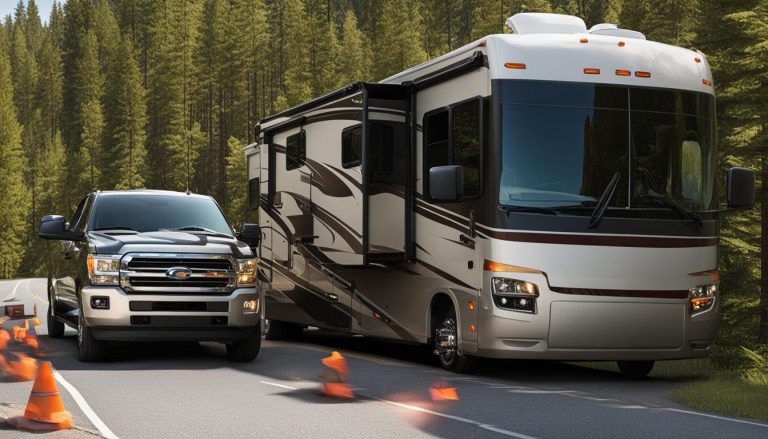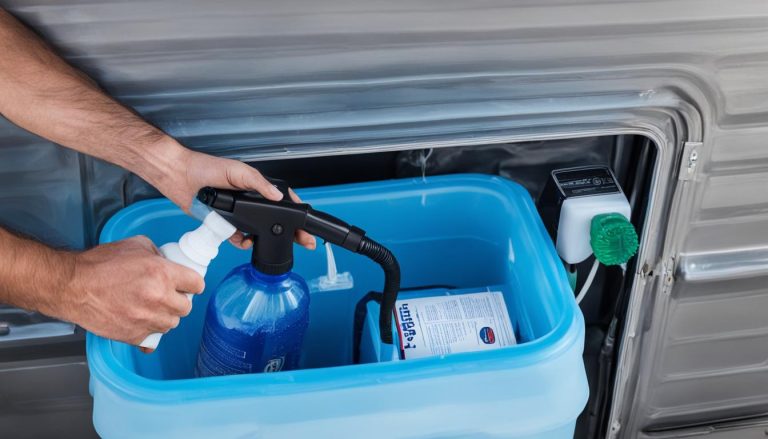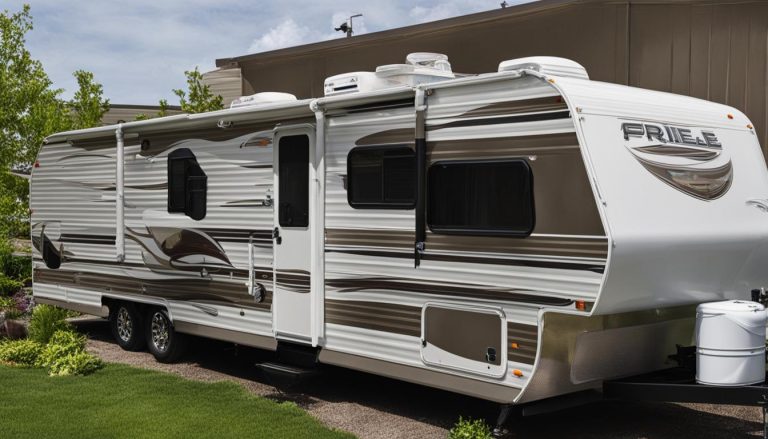Sanitize Your RV Water Tank – Step-by-Step Guide
gorvlifestyle.com and its partners may earn a commission if you purchase a product through one of our links
Keeping the water in your RV fresh and safe for use is essential for a comfortable and enjoyable camping experience. Regularly sanitizing your RV water tank is a crucial maintenance task that ensures the water you drink, shower in, and use for cooking and cleaning is free from harmful bacteria and contaminants.
Whether you’re preparing for the camping season or it’s been a while since you last used your RV, this step-by-step guide will walk you through the process of sanitizing your RV water tank. By following these simple steps, you can ensure that your RV’s water system remains clean and hygienic, providing you with peace of mind throughout your travels.
Key Takeaways:
- Regularly sanitizing your RV water tank is crucial to ensure safe drinking water and clean water for daily use.
- The recommended frequency for sanitizing your RV water tank is typically once a year or whenever it has been unused for 2-4 weeks.
- You can use bleach or a more environmentally-friendly cleaning solution to sanitize your RV water tank.
- No special tools are needed for the sanitization process, and it can be done using common household items.
- Following the proper steps for sanitizing your RV water tank will help maintain the longevity and functionality of your RV’s water system.
How Often Should You Sanitize Your RV Fresh Water Tank?
Regular maintenance and sanitization of your RV’s fresh water tank is crucial to ensure clean and safe water for all your needs on the road. But how often should you sanitize your RV water tank? The answer may vary depending on individual preferences and usage patterns.
According to manufacturers, the fresh water tank in your RV should be sanitized “after each use.” However, this recommendation can be interpreted differently by RVers. Many choose to sanitize their fresh water system once a year, typically in the spring, as part of their annual dewinterization routine. This offers a fresh start to the camping season and ensures that the water tank is free from any contaminants that may have accumulated during winter storage.
On the other hand, some RV owners prefer to sanitize their water tank more frequently, especially if the vehicle has been unused for an extended period, typically 2-4 weeks. This proactive approach guarantees clean water and peace of mind, especially when it’s uncertain how the RV was stored or if there’s a chance of bacterial growth. Sanitizing the water tank after a period of inactivity is particularly important, as stagnant water can create a breeding ground for harmful bacteria.
Regular sanitization not only helps maintain water quality but also promotes good hygiene for activities such as drinking, showering, dishwashing, and laundry on the road. By following a consistent sanitization schedule, you can ensure that your RV’s water system remains in optimal condition throughout your adventures.
It’s worth noting that the process of sanitizing your RV fresh water tank is relatively straightforward and does not require any special tools. Whether you choose to use bleach or opt for a more environmentally-friendly cleaning solution, the key is to follow a systematic and thorough approach to get the best results.
Proper sanitization leads to worry-free water usage
To maintain a consistently clean and safe water supply in your RV, it’s important to prioritize the regular sanitization of your fresh water tank. By incorporating this essential maintenance task into your routine, you’ll be able to enjoy worry-free adventures on the road, confident in the knowledge that your water is free from contaminants.
Next, we will explore the materials and steps required to effectively sanitize your RV fresh water tank, including different methods and tips to ensure a successful sanitization process.
What Do You Need to Sanitize your RV Fresh Water Tank?
Sanitizing your RV fresh water tank doesn’t require any special tools. Here’s what you’ll need:
- A measuring cup
- A funnel
- A 5-gallon bucket or water storage container
- A potable water hose
- Non-scented bleach or RV tank sanitizer
- A water tank filler (optional)
It’s important to use the correct amount of bleach for your tank size and dilute it in water before adding it to the fresh water tank.
How To Sanitize RV Fresh Water Tank with Bleach
Before you start sanitizing your RV fresh water tank with bleach, it’s important to take a few necessary steps. First, turn off your water heater and water pump to prevent any potential damage to the tank. Next, open all the faucets in your kitchen and bathroom to allow air to assist in completely draining the water. This will help ensure a thorough sanitization process.
Now, locate the fresh water tank drain and low-point drains for your RV’s plumbing lines. Open these drains to use gravity and naturally drain water from your freshwater tank, plumbing lines, and hot water tank. This step is crucial in preparing your tank for the sanitization process.
Next, you’ll need to calculate the amount of bleach you’ll need based on the size of your fresh water tank. It’s important to use the correct amount to ensure effective sanitization. Dilute the bleach in water and add it to the fresh water tank using a funnel. This ensures an even distribution of the bleach mixture throughout the tank.
Now, it’s time to fill the tank with potable water and pump the diluted bleach mixture through the system. This step helps to ensure that the entire water system in your RV is thoroughly sanitized. Allow the water to sit in the tank for 12-24 hours to properly sanitize it.
Once the designated time has passed, it’s time to drain the tank and flush the system with clean water. This step helps remove any remaining bleach and ensures that your fresh water tank is free of any cleaning solution.
By following these effective methods to sanitize your RV fresh water tank with bleach, you can ensure that your water system remains clean and safe for use during your travels.
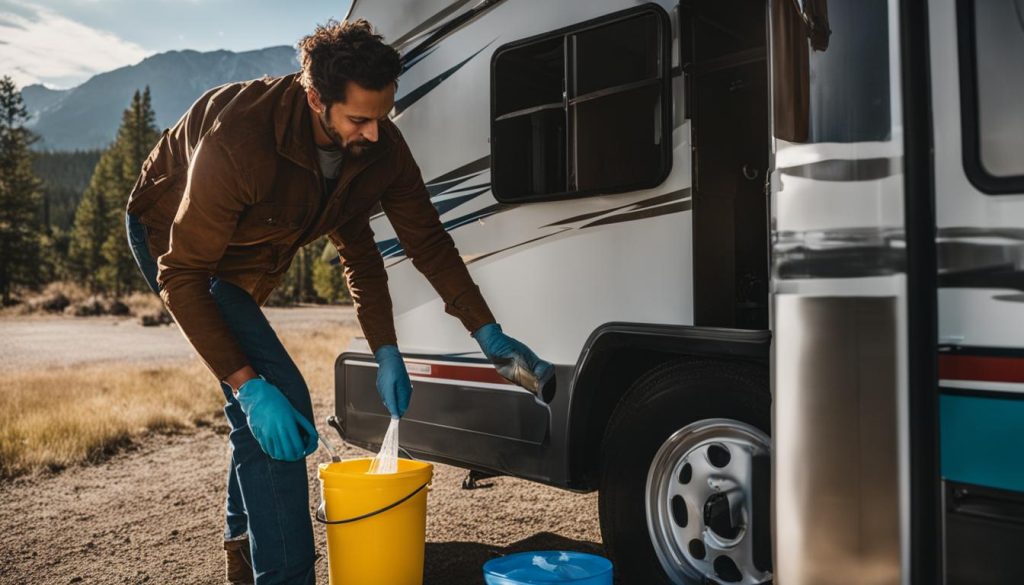
| Fresh Water Tank Size | Amount of Bleach | Amount of Water |
|---|---|---|
| Less than 30 gallons | 1/4 cup | 1 gallon |
| 30-60 gallons | 1/2 cup | 1 gallon |
| More than 60 gallons | 1 cup | 1 gallon |
Tips for Sanitizing RV Fresh Water Tank
When it comes to RV water tank maintenance and sanitization, following a few additional tips can help ensure a clean and safe water system in your RV. Here are some key pointers to keep in mind:
- Before sanitizing, make sure your gray water holding tank is empty. This will prevent any unwanted mixing of chemicals and ensure effective sanitization.
- When choosing a location to drain the bleach solution, consider the impact it may have on your neighboring campers. Aim to avoid creating a pool of water in their site.
- Check the hose clamp on the filler tube to ensure it is tight. This will prevent any leaks during the sanitization process.
- Use a bleach product that is safe for all components of your RV’s water system. This will help prevent any damage or corrosion.
- After sanitizing, fill your fresh water tank with clean water. If desired, use an RV water filter to further enhance the quality of the water.
- To ensure thorough sanitization, circulate the bleach solution through all faucets and showerheads for 2-3 minutes. This will ensure that every part of the water system is properly treated.
- Allow the diluted bleach solution to sit in the tank for 12-24 hours before draining. This will give enough time for effective sanitization.
By following these tips, you can DIY water tank sanitization in an RV and maintain a clean and safe water system throughout your travels.
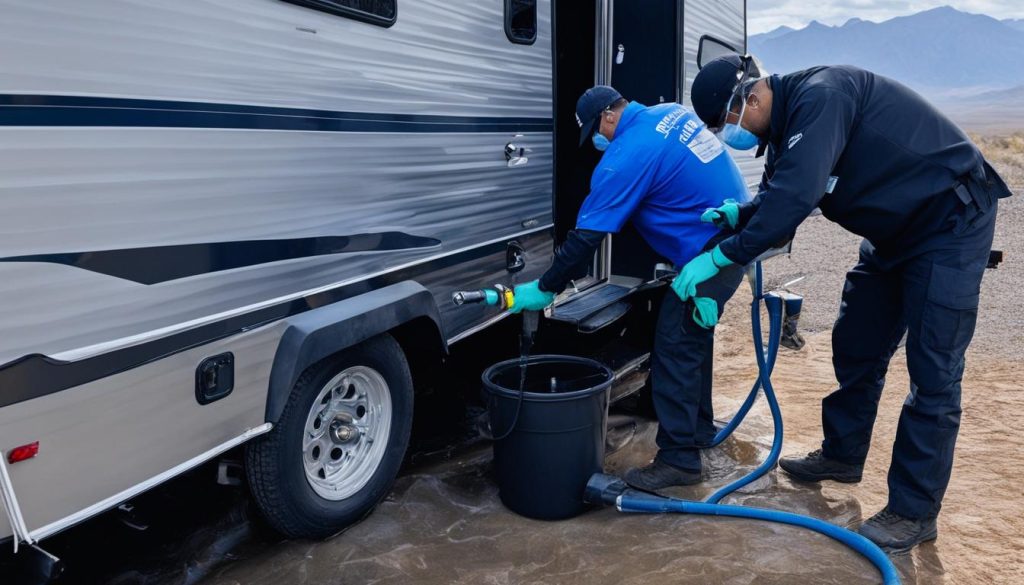
Additional Considerations for Sanitizing RV Fresh Water Tank
When sanitizing your RV fresh water tank, it’s important to consider a few additional factors to ensure effective disinfection and maintain the longevity of your RV’s components. Firstly, avoid draining the bleach solution directly into the soil, as it can harm plant life and degrade soil health. Instead, consider draining the tank into a portable RV holding tank or a sewer connection for proper disposal.
Secondly, be cautious with the rubber components in your RV, as bleach has the potential to degrade them over time. To prevent unnecessary wear and tear, it’s recommended to limit contact between the bleach solution and rubber materials during the sanitization process.
If you’re running the bleach solution through your plumbing system and into your gray water tank, ensure a complete drain by opening the low-point valve after shutting off the water pump. This step guarantees that any residual bleach solution is fully expelled from the system.
Alternatively, if you prefer to use an environmentally friendly cleaner instead of bleach, you can drain the tanks the same way you initially prepared for the sanitization process. Remember to always follow the manufacturer’s guidelines when using any cleaning solution.
Lastly, after draining the tank and completing the sanitization process, it’s crucial to refill your fresh water tank with clean water to flush out any remaining bleach. This step ensures that your RV’s water is safe for use and free from any chemical residue.
FAQ
How often should I sanitize my RV fresh water tank?
It is recommended to sanitize your RV fresh water system once a year, ideally in the spring when preparing for spring camping. However, some RVers choose to sanitize their tank every time it has been unused for 2-4 weeks.
What do I need to sanitize my RV fresh water tank?
To sanitize your RV fresh water tank, you will need a measuring cup, funnel, 5-gallon bucket or water storage container, potable water hose, non-scented bleach or RV tank sanitizer, and a water tank filler (optional).
How do I sanitize my RV fresh water tank with bleach?
To sanitize your RV fresh water tank with bleach, start by turning off your water heater and water pump. Open all the faucets to allow air to assist in draining the water. Locate the fresh water tank drain and low-point drains and open them to drain the water. Dilute the bleach in water and add it to the fresh water tank. Fill the tank with potable water and pump the mixture through the system. Let it sit for 12-24 hours before draining and flushing with clean water.
Any tips for sanitizing my RV fresh water tank?
Yes, here are some tips for sanitizing your RV fresh water tank: ensure your gray water holding tank is empty before sanitizing, park your RV in a location where draining the bleach solution won’t create a pool of water in your neighbor’s site, check the hose clamp on the filler tube for tightness, use bleach that is safe for all components of your RV’s water system, fill your tank with clean water and use an RV water filter if desired, circulate the bleach solution through all faucets and showerheads for 2-3 minutes, and let the water sit in the tank for 12-24 hours before draining to ensure proper sanitization.
Are there any additional considerations for sanitizing my RV fresh water tank?
Yes, when sanitizing your RV fresh water tank, avoid draining the bleach solution into the soil as it can harm plants and soil health. If possible, drain the tank into a portable RV holding tank or sewer connection. Be cautious with rubber components in your RV as bleach can degrade them over time. If running the bleach solution through your plumbing system and into your gray water tank, open the low-point valve after shutting off the water pump to ensure a complete drain. If using an environmentally friendly cleaner instead of bleach, drain the tanks the same way you initially prepared for the sanitization process. Finally, refill your fresh water tank with clean water after draining to flush out any remaining bleach.

